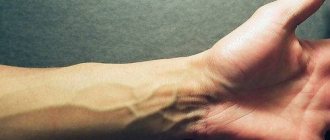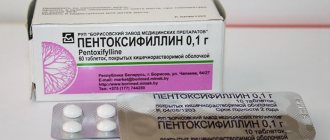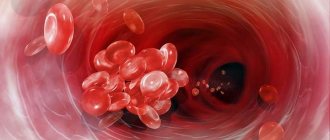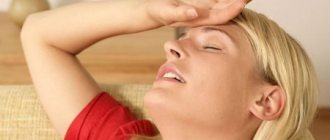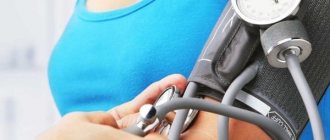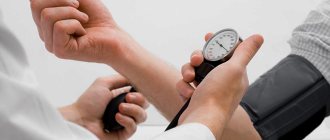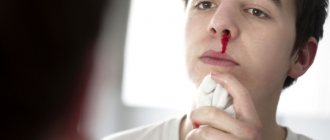Vessels are an integral part of the circulatory system. The blood flow in the body depends on their functioning. Some pathologies are characterized by rupture of blood vessels. In this case, spontaneous hematomas may appear. They occur either due to injury or due to internal disorders.
You need to understand that at the first manifestations of such a problem you should immediately consult a doctor. In a healthy person, blood vessels may occasionally burst under the influence of certain factors. However, this phenomenon is infrequent and manifests itself only as bruises. If hematomas occur constantly due to unknown reasons, then you need to visit a doctor. A phlebologist treats such problems.
Causes
Many people are interested in what a burst blood vessel on the hand looks like. This process manifests itself as bruises. Fragility of the bloodstream is most often observed in old age. This is due to the accumulation of salts, cholesterol and lipids. Accordingly, the vessels wear out, their functionality begins to deteriorate, and problems with elasticity appear. It is important to consult a doctor immediately when the first symptoms occur, otherwise you may wait for unpleasant consequences to develop.
Many people wonder how to deal with the fact that a blood vessel in their hand has burst. The causes are the most important factor that influences further treatment. There are external and internal provoking conditions.
The first is the following list:
- excessive loads;
- ingestion of chemicals into the body;
- thermal effects;
- injuries;
- allergies to cosmetics;
- taking medications that affect the condition of blood vessels;
- prolonged stress;
- sedentary lifestyle.
Internal reasons include:
- endocrine system disorders;
- kidney and liver problems;
- elderly age;
- high blood pressure that occurs too often;
- stress;
- hormonal imbalance (or taking hormonal medications);
- HIV;
- infections that affect the condition of blood vessels;
- allergies to medications;
- lupus erythematosus;
- excess weight;
- oncology;
- avitaminosis;
- constant pressure surges;
- problems with blood circulation in the brain.
Causes and treatment of vascular fragility due to vasculitis in children
The exact causes of the primary pathology have not been established. Provoking factors include autoimmune diseases, chronic infections, allergies to medications, overheating and hypothermia. The disease may be associated with vaccination, since in some cases the administration of the vaccine causes negative reactions from the vascular system. Sometimes vasculitis occurs on its own, without any prerequisites.
Typical signs of vasculitis:
- Fatigue, fainting;
- Migraine;
- Vomit;
- Decreased vision;
- Loss of sensation in limbs;
- Hard breathing.
Inflammation spreads to the joints due to damage to the arteries. Treatment in this case is characterized by a comprehensive approach and duration. Therapy is carried out exclusively in a hospital setting.
Medicines are selected taking into account the goals of treatment:
- stop the stage of the disease, prevent complications;
- eliminate the risk of death in severe cases;
- relieve symptoms;
- prevent consequences.
The main cure for fragility of blood vessels in this case is glucocorticoid drugs. Cytostatics and indomethacin are also used. Medications may be prescribed to dilate blood vessels and support elasticity.
Symptoms
If a person’s blood vessels burst on his hands and bruises appear, then he should pay attention to his condition as a whole. Bleeding from the nose can often be a concern. If a similar problem is observed in the warm season, then cyanosis of the skin occurs and a feeling of chills appears.
For any patient, a hot day will bring only trials. The patient complains of dizziness, pain in blood vessels, aches, tachycardia and loss of consciousness. There may be problems with the vestibular apparatus. Spider veins can be seen on the skin. They appear due to the fact that the capillaries rupture.\
If a person develops subcutaneous hematomas on his hands, he should immediately consult a doctor. He will be able to prescribe effective treatment.
Treatment options
If a vein on a finger bursts, the vessels on the fingers burst, the reasons for which are already known, that is, there are a number of therapies that help with this disease, and also act as an additional prevention against blood stagnation.
What to do if blood vessels in your hands burst? In order to relieve pain from this disease, the injured area must be lubricated with Troxevasin. This drug increases the tone of blood vessels, strengthens their walls, penetrating into the very epicenter of the rupture, and alleviates pain in the area of bruising.
Now let’s look at the general treatment package if a vein in the arm bursts (look at the photo), what to do in this case:
- at the very beginning of treatment, it is necessary to generally strengthen the walls of blood vessels with the help of various medications . They help restore the elasticity of blood vessels, which prevents their fragility and further ruptures;
- physical activity is very useful , which contributes to additional circulation of blood throughout the body, which helps to develop and strengthen the walls of blood vessels, and also has a positive effect on overall well-being;
- if you have a strong immune system, then you can resort to the hardening . Once a week, douse yourself alternately with cold and hot water - this will give your circulatory system a great shake-up, which will have a positive effect on blood flow. However, this method of strengthening blood vessels should be discarded by those who have abnormal fragility of blood vessels. This procedure can only provoke further hemorrhages;
- if you smoke, then you need to quit the bad habit , or reduce your daily nicotine consumption to the maximum;
- changing your diet and including healthy foods in it also has a beneficial effect on solving this problem. This way you solve the problem from the inside every day.
Medicines
If a vein in the hand bursts and capillaries on the fingers burst, the reasons for which are stated, then they usually resort to the following drug treatment. An effective remedy for maintaining and strengthening the walls of the circulatory system, as well as in case of burst vessels in the arms and legs, is Troxevasin ointment. It is also effective in resolving bruises and small capillary hemorrhages.
An important vitamin complex containing elements C and P is ascorutin, capillary, rutoside. Before using these medications, you should consult your doctor.
Regular aspirin will help thin the blood and prevent blood clots. It is only important to take it carefully; blood clotting when taking this drug is greatly reduced.
Folk remedies
In order to ensure that your blood vessels are always normal and that unexpected hemorrhages do not occur, it is necessary to provide them with maximum vitamin support. For good blood circulation, its renewal and other necessary functions, it is important to eat foods such as:
- beet;
- tomatoes;
- apricots;
- berries (cherries, cherries, chokeberries, currants);
- greens (parsley, dill, green onions);
- citrus;
- You can also rub vitamin E into the skin; this product restores skin elasticity, which reduces the possibility of ruptures of small capillaries;
- Rubbing aloe juice into damaged skin helps get rid of inflammation, which has a beneficial effect on blood vessels.
important to check the patency of the veins with a specialist at least once a year in order to exclude the possibility of diseases of the circulatory system. If blood vessels regularly burst in the legs and arms, this is abnormal.
Diagnostic methods
In order to select competent therapy, it is necessary to perform all diagnostic measures. This stage is considered quite important. Let's look at the most effective tests:
- You need to take a rubber band and tie it above the elbow. After five minutes it needs to be removed. If a bruise appears, then urgent treatment should be started.
- If there are problems with blood vessels, gentle blows to the chest with a hammer will cause hematomas.
- The pinch method is the most commonly used. Near the collarbone, you need to gather the skin into a fold, turn it 90 degrees and squeeze a little. If the patient does not have problems with blood vessels, then a bruise will not appear.
Those patients who have weak capillaries are advised to take additional blood and urine tests. It is especially important to check for a coagulogram. ECG and capillaroscopy will not be superfluous. Thanks to them, you can understand how well blood moves through the vessels. Thanks to modern technologies, it will be possible to identify the condition of each capillary separately.
Vascular disorders in the spine (hemangioma)
Disturbances occurring in the vascular structure of the spine, as a result of the proliferation of newly formed blood vessels located in the area of the vertebral body, lead to a decrease in its strength (bone tissue restructuring). As a result of such vascular changes, the formation of a slowly growing vascular tumor, which can be of different sizes, is possible. Refers to a primary benign tumor. It's called a hemangioma.
Localization for vascular disorders in the spine
Appearance of a tumor
It can appear in other bone structures of the human body, but most often it appears in the spine. In most cases, one body (vertebra) is affected, but there are lesions of several vertebrae (from 2 to 5, more than 5 are rare) at the same time - hemangiomatous lesions.
The appearance of the tumor is observed in adults, mainly females, after 40 years, and is very rare in children. Tumor enlargement appears with age.
The frequency of manifestations is noted:
- in the first place - in the thoracic spine - the sixth thoracic vertebra; - in the second - in the lumbar region;
- in third place - in the cervical and sacral regions (noted in 1% of cases).
The pathogenesis of the disease does not have an exact definition, but the causes of tumor development according to the determining factors are: - genetic predisposition; - local tissue hypoxia; - high estrogen content; - anatomical inferiority of the structure of the vascular walls of certain vertebrae.
The latter reason becomes a favorable condition in the event of microtrauma to the vertebra. This structure will cause an increase in the load on the affected vertebra.
Trauma and periodic hemorrhages destroy the structure of the vertebral bone, activating a function that forms defective new vessels and at the same time disrupting the free movement of blood through the vessels due to the formation of a blood clot (the appearance of antigenic thrombosis).
Classification of histological structural formations
| Structure | Manifestations |
| Capillary (simple) - the most common type | Less symptomatic. They have different sizes, consist of intertwined formations of vessels and capillaries, the walls of which are thin, while the channels are separated by adipose and fibrous tissue. They are arranged in several layers. |
| United racematous branches | Characterized by the presence of a connected formation of venous or arterial vessels |
| Cavernous hollow structure | It appears painful. It represents several cavities that are separated by thin hypertrophied connective tissue septa. The walls of blood vessels do not have elastic fibers. Feeds one or more large vessels |
| Mixed | The structure will depend on the volume of the lesion, and will include thin-walled capillaries, large vessels of enlarged cavities |
Depending on the location of the development of the pathological process of hemangioma in the anatomical structures of the vertebra, the degree of damage is distinguished: localized and isolated, when the entire vertebra is affected, only its body, the body and the posterior semi-ring, the spinal cord canal. The increase in education is determined by dynamic criteria.
Clinical course of vascular disorders in the spine
Considering the low-symptom nature of this pathology, manifestations of aggressive forms are of clinical significance. The clinical picture will have a local pain syndrome.
In some cases (1/3 of detections) there are concomitant degenerative-dystrophic changes in the structures of the spine.
The degree of aggressiveness of absolute signs classifies: small hemangiomas (do not require clinical observation), non-aggressive and aggressive.
Clinical picture
Dynamic observation is carried out to timely determine the mechanical impairment of the vertebral body. The spread of the tumor beyond the vertebra can be combined with compression syndrome, followed by vertebral fracture.
Accompanying neurological disorders with extradural location of the hematoma appear when the spinal cord is compressed.
The compressed position of the nerves causes pain to occur both when the entire vertebral body is involved and when there are vascular anomalies.
It is possible that the complete absence of clinical manifestations of the tumor throughout the life of the body can be determined by chance during examination of other pathologies of the spine.
The definition of the clinical manifestation of this pathology will be positive: with the active appearance of a large tumor formation, with a decrease in the height of the vertebra, with its collapse, with the expansion of the vertebra by a formation that causes tension in the longitudinal ligaments (anterior and posterior), i.e. at the peak of the pain syndrome.
The motor activity of the spinal column decreases.
The localization of pain will be determined at the location of the affected vertebra and will intensify when turning. Pressure from the tumor can act not only on the spinal cord, but also on the vertebral body, causing periosteal irritation of the receptors, thereby causing pain.
In the presence of an epidural hematoma, the roots of the spinal cord are irritated, with the appearance of myelopathic syndromes.
Diagnosis of vascular disorders in the spine
The diagnostic definition is made more often by neurologists, during a neurological examination based on MRI data (the type of hemangiomas is determined - the most informative method) and CT (allows one to determine structural pathology). The need for clinical and radiological examination is taken into account.
Radiological signs of a tumor process will be lesions that cause the restructuring of bone tissue. They are observed with aggressive or potentially aggressive hemangiomas. Data from modern observations provide the basis for conducting a laboratory examination, because formations may have different pathomorphological structure.
The diagnostic algorithm includes: venospondylography (digital spondylography), radionuclide studies, selective angiography. Clinical manifestations of hemangiomas and the result of treatment are assessed using the original quality of life scale. The examinations are supplemented by determining the presence of neurological dysfunctions.
The direction of treatment will be determined by the degree of bleeding.
The minimal size of the hemangioma reduces the risk of developing possible complications.
Treatment methods for hemangioma
Treatment methods for hemangioma
There are quite a lot of radical methods for solving the problem, but many of them are dangerous for the future health of patients, such methods include: x-ray therapy, exposure of the tumor component to radiation.
- partial resection of the affected bone or removal of a component of the formation is difficult to access technically. - sclerosis of the hemangioma, without the addition of stabilizing systems, complications may occur in the form of compression fractures of the vertebral bodies.
-transvasal embolization (artificial thrombosis) causes blockage of blood vessels.
The best effect without postoperative complications in the treatment of hemangiomas is achieved by the most modern treatment method - puncture bone vertebroplasty.
The advantage of this method is the prevention of compression fractures and increased biomechanical strength of the vertebral body.
The purpose of this treatment method is indicated for aggressive forms of hemangioma, taking into account the presence of degenerative changes in the spine. It can be performed in two stages: vertebroplasty, with surgical removal of the epidural component of the tumor.
Source: https://pozvonochnik-cheloveka.ru/sosudistye-narusheniya-v-pozvonochnike-gemangioma.html
Treatment methods
If the cause of vascular rupture is injury, then urgent action is not necessary. The bleeding will stop over time. The main thing is to provide emergency assistance correctly.
If blood vessels on the wrist or other part of the hand burst due to exposure to chemicals, you need to reduce the effect of the latter on the body. Personal protective equipment should be used to allow the capillaries to recover. With prolonged exposure to such substances, the vessels begin to thin out and become brittle.
Massage and hardening should be included in the therapeutic course. You need to give up all bad habits. The doctor is also required to prescribe medications and vitamins. Treatment should be aimed not only at eliminating the root cause, but also at strengthening the walls of blood vessels. The patient's diet plays an important role here.
Treatment
Medicines that strengthen vascular walls and improve blood circulation can help cope with the fragility of blood vessels. They can be prescribed by a doctor after consultation and tests.
To quickly resolve the problem, the following ointments are used:
- Troxevasin;
- Troxerutin;
- Heparin;
- Bruise-OFF;
- Lyoton.
These drugs relieve swelling, have an anticoagulant effect and quickly eliminate bruises.
Askorutin
Ascorutin is a combination drug from the group of capillary stabilizing agents. The medicine contains ascorbic acid and rutoside trihydrate (vitamin P). The drug reduces the fragility and permeability of capillaries, strengthens the walls of blood vessels, has an anti-inflammatory effect and reduces platelet aggregation.
Ascorutin should be used for 3-4 weeks
Ascorutin is taken after meals, 1 tablet 2-3 times a day. Depending on the nature of the disease, treatment is continued for 3–4 weeks.
Contraindications to the use of the drug are:
- increased blood clotting;
- diabetes;
- gout;
- urolithiasis disease;
- severe renal dysfunction;
- hypersensitivity to its components.
Diet
Any person will be able to notice that a blood vessel on his hand has burst. What to do? In addition to medical treatment, you must follow a diet. You need to add more vitamins to your diet. You should eat chicken, rabbit, and cow meat. Fish also has a good effect on the body. You should enrich your diet with vegetables and fruits as much as possible. Nuts and legumes won't hurt. Fermented milk products also have a good effect.
Pickled vegetables, flour, bread, smoked foods, alcohol, coffee and soda are prohibited.
Treatment of the disease
What to do if blood vessels in your hands burst?
If it is not possible to buy hypoallergenic household chemicals, then you need to use them with gloves.
The main thing in treatment is to strengthen blood vessels and increase their elasticity. It is important to review your diet, remove what is unnecessary and add what you need. With this disease, it is necessary to consume a lot of vitamins not only in dosage form, but also in food, since it is the lack of vitamins that leads to weakening of capillaries and blood vessels. Top tips:
- Review all household chemicals, determine the presence of allergic reactions and do not use such products or use rubber gloves. And also check all cosmetics, shower gels, shampoos, etc.
- Exercise. It is known that poor blood circulation harms blood vessels, so to improve their elasticity you need to speed up blood circulation. To start, do exercises in the morning, you can go jogging, and also sign up for a sports section and lead an active lifestyle, toughen up, and don’t drink alcohol.
- If a hematoma or bruise forms due to a blow or bruise, you should not worry and carry out any treatment, the bruise will go away on its own, but you can use special ointments for bruises, for example, “Bruise-OFF”.
- If bruises appear on your body for no reason, consult a specialist; most likely, this is a pathology; you cannot delay it. The doctor will determine the extent of the disease, the need for surgical intervention, and prescribe the necessary medications and diet.
It is important not to delay treatment, then the patient has a better chance of recovery. Otherwise, surgery will be required.
Drugs
Different groups of medications are prescribed:
For atherosclerotic pathology, Lovastatin is prescribed.
- For atherosclerosis, which has caused burst capillaries, it is recommended to take Lovastatin, Atorvastatin or Fenofibrate.
- Vitamins - “Capilar” and “Vitrum”, “Ascorutin” and “Complivit”. It is advisable to eat citrus fruits, raspberries, tomatoes, and currants.
- To strengthen blood vessels, they use gels; to reduce swelling, they use “Troxevasin”, phlebotonics, such as “Detralex”, “Phlebodia”, venotonics - “Aescin”, “Eskuzan”.
- When capillaries are destroyed due to contact with an allergen, Cetrin or Suprastin are used.
- If the cause is a sharp increase or decrease in blood pressure, then antihypertensive drugs are prescribed - Capoten, Lorista or Enalapril.
Folk recipes
Healers offer the following remedies:
- Infusions and decoctions of currants and walnut leaves.
- Lemon juice helps give elasticity and strengthen blood vessels. Drink two glasses of water with honey and lemon every day. You can make a tincture with garlic for additional cleansing. It is also recommended to consume 2-3 cloves of garlic every day.
- Various teas: from rose hips, currants, cranberries, pine needles. In autumn, it is recommended to eat rowan fruits.
- Using turpentine for baths. Strengthens blood vessels.
Proper nutrition
Prohibited:
People with this pathology should not eat canned food.
- smoked food;
- baked goods;
- fatty foods;
- pickled vegetables, canned food;
- salty and sweet;
- coffee;
- sparkling water and alcohol.
Allowed:
- chicken, rabbit, veal, beef and fish;
- vegetables and fruits;
- various cereals;
- pasta;
- nuts;
- legumes;
- Dairy products.
Medicines
The doctor will prescribe medications that relieve swelling and inflammation of blood vessels. An excellent remedy is “Suprastin”. It allows you to get rid of capillary fragility if it is the result of an allergy. “Enap” and “Captopril” are used for high blood pressure, which has affected the condition of the blood vessels. “Troxevasin” is necessary for all patients, regardless of why a blood vessel burst on a finger or in another place. It will strengthen the walls of the capillaries.
Sometimes doctors use instrumental treatment methods. Laser and pulsed light are used. Microsclerotherapy is also effective. If the case is too complex and is not corrected with medications, then doctors may prescribe surgery, during which the vessel will be removed.
Why do blood vessels on the hands burst and bruises appear?
Before you understand why blood vessels in a finger burst, you need to understand what the vessels are.
The circulatory system is very strong, and when it is healthy, not every blow or bruise can lead to a hematoma, rupture of capillary walls or a bruise.
Otherwise, the frequent appearance of such signs indicates disturbances in the body , as well as weakness of the walls of blood vessels, it is necessary to consult a specialist.
The causes of a burst blood vessel on a finger (see photo below) are very diverse.
- The most common cause of burst capillaries is trauma and bruises. The impact causes rupture of the vessel wall and internal hemorrhage. In this case, there is no reason to worry, and the bruise will go away on its own.
- Pathology of the thyroid gland also affects the fragility of the circulatory system.
- Diabetes.
- Kidney pathologies.
- Stress.
- Burns, frostbite, frequent visits to the solarium.
- Peeling with rough washcloths and gloves can also lead to the destruction of capillary walls from frequent friction.
- Vegetovascular diseases.
- Hypertonic disease.
- Strong physical activity leads to increased pressure, which causes the capillary wall to rupture. In this case, you need to slow down your training pace.
- Allergy to household chemicals. If you washed the dishes with a new product, and a blood vessel burst on your finger and a bruise appears, what should you do? It is necessary to take an antiallergic drug and change the detergent.
- Excess weight leads to additional stress on the circulatory system, which can cause varicose veins of the lower veins, vascular nodules with bruising and other internal injuries to the veins.
- A sedentary lifestyle leads to blood stagnation, which leads to blood clots.
- Fragility of the walls of the circulatory system as a whole. This disease manifests itself mainly in older people, due to the development of atherosclerotic plaques. These bodies accumulate in the vessels, which interferes with their patency.
- Lack of vitamins B, B5, C, P, PP, Rutin and others also negatively affects the strength of capillary walls.
- Passive lifestyle.
- Hormonal imbalance in women.
- Complications after an illness and reduced immunity can also lead to a blood vessel bursting on a finger and a bruise appearing. What to do in this case? We'll tell you a little later.
Traditional methods
Some traditional medicine methods can help if burst blood vessels appear on your hands.
Garlic is the most popular remedy. You should eat 2 cloves per day. Then the vessels will become strong and elastic. You can also use any decoctions of lemon juice, black currant, rowan, rose hips, and walnuts. All of them are enriched with a large amount of vitamins, which has a great effect on the condition of a person and his blood vessels individually. However, you need to remember that some drugs have contraindications. Before using this or that decoction, you should consult your doctor.
Prevention
The recommendations are simple:
- If veins burst, exclude junk food, heavy, fatty foods, sweet drinks, and alcohol from your diet.
- Include citrus fruits, currants, and rowan in your diet. Also eat foods that improve blood circulation (raspberries, cherries, apricots, tomatoes, parsley).
- It is useful to eat buckwheat and drink green tea, and take a course of vitamins to prevent vascular rupture.
- Eliminate stress, nervous tension, monitor your blood pressure, exercise every day (morning exercises are enough).
- Have a massage (you can make an appointment, or you can rub the skin on your palms and arms yourself).
The main preventative measure is taking care of your health in general, timely treatment of diseases, and a healthy lifestyle. It is important to remember that when capillaries on the fingers or on the hands themselves burst for no reason, this indicates the presence of some kind of health problem and it is necessary to immediately contact a phlebologist and carry out a diagnosis.
Gel “Badyaga Forte”
This drug helps fight bruises and hematomas. Therefore, if an unpleasant stain appears in the most visible place due to burst blood vessels, you can remove it using this product.
The main “ingredient” of the gel is badyaga. This is a freshwater sponge. It is caught in reservoirs. As a rule, it accumulates on snags and stones. It is dried and then ground into powder. This gel, when applied to the skin, causes surface irritation. Because of this, the vessels dilate and begin to move blood faster. The product also has a resolving and bactericidal effect.
Symptoms: what does a burst vessel look like?
In the meantime, it’s worth looking at what symptoms accompany capillary rupture.
Usually, everyone knows what a bruise and hematoma look like - extensive internal hemorrhage caused by ruptured capillaries.
A burst vessel, like the appearance of red dots on the body, is not a rare phenomenon.
When a blood vessel bursts on a finger, a blue spot is visible to the naked eye, the touch of which is painful.
To identify the fragility and fragility of capillary walls, several methods are used:
- Pinch method - select an area of skin that has the lowest pain threshold, pinch this fold with your fingers and move it several times. In such places, accidental injuries are excluded, and if a bruise occurs at the site of the pinches, then the fragility of the blood vessels is confirmed.
- Tourniquet method - with this tourniquet the arm is pulled above the elbow joint, and if after removal a bruise forms under the site of the constriction, then problems with the blood vessels are confirmed.
What effect does the gel have?
The instructions for the drug describe the effect that the use of the gel leads to. It will be an excellent method for combating bruises due to burst blood vessels. Hematomas on the hands are easy to hide, but sometimes they can cause severe pain. The gel will be able to eliminate it. It also relieves itching. It is able to enhance the properties of the immune system, normalize blood circulation, which is important, restore the skin, and combat the active work of the sebaceous glands. The gel can also be used when exfoliating surfaces, as it tones and regenerates them.
Many people use the described remedy for swelling. The gel can also warm up the skin. Due to the fact that it contains essential oils, the drug fights dead cells. You can use the gel for rejuvenation, but keeping it on for more than 20 minutes is not recommended.
Preventive actions
To minimize the likelihood of pathologies arising from a burst vein, it is necessary to take care in advance about daily preventive measures that will strengthen the walls of blood vessels, making them stronger and more elastic. They consist of certain actions that a person who wants to maintain healthy veins must perform:
- do not lift objects heavier than 8 kg;
- give up alcoholic beverages, smoking, and taking drugs;
- Once a year, take a blood sample for platelet concentration and biochemical composition in general;
- conduct a general blood test with determination of coagulogram and biochemistry (according to indications);
- Before going to bed, be sure to take a shower with water at room temperature to improve blood circulation and tone blood vessels;
- do not take oral contraceptives and anabolic steroids;
- when sitting for a long time, be sure to raise your legs up for 10 minutes at intervals of 1 hour to ensure the outflow of venous blood;
- engage in active sports (running, swimming, cycling, race walking).
These simple prevention methods will help avoid rupture of veins, and will also strengthen all parts of the cardiovascular system.
People who pay attention to preventive measures almost never encounter pathologies of the venous vessels.
Diet and lifestyle
To prevent veins from bursting on the knees, feet, arms and other parts of the body, you need to take care of the quality of your diet. The diet of a person paying attention to the prevention of vascular rupture is as follows:
| Prohibited Products | Recommended food |
| Bacon, lamb, all fatty meats and fish | Chicken breast, rabbit, turkey, nutria |
| Convenience foods and fast food | Rosehip tea with a slice of lemon |
| Confectionery and bakery products made from white wheat flour | Fresh fruits, vegetables, all types of greens |
| Carbonated drinks | Dairy products |
| Alcohol | Honey, which is an alternative to sugar |
| Dishes with a high concentration of sugar | Rye flour bread |
| Salted, pickled, smoked food | Cereals |
| Strong tea, coffee | Pasta made from durum wheat |
Phytotherapy
In addition to following dietary standards, it is recommended to include the following decoctions based on medicinal plants in your diet:
- Sweet clover officinalis. Add 300 ml of boiling water to 6 g of plant, leave in a warm place for 2 hours. Take a quarter glass three times a day 15 minutes after meals.
- Highlander. Boil 5 g of the plant for 2 minutes in 300 ml of water, then let it brew in a warm place for 1.5 hours. Take a quarter glass half an hour before meals three times a day.
- Hazelnut (hazelnut). A standard decoction of tree leaves in a concentration of 10 g per 300 ml of water is used in a third of a glass 3 to 4 times a day before meals.
These folk remedies are excellent not only for preventing the rupture of venous vessels, but are also used to prevent the development of varicose veins and thrombophlebitis. They will be useful for people whose occupation does not involve high activity.
In combination with the above preventive measures, decoctions based on medicinal herbs will ensure the integrity of the walls of venous vessels and will prevent their sudden rupture even under static load conditions.
A vein can burst due to external influences, concomitant diseases of the cardiovascular system, improper nutrition and lifestyle. To avoid pathologies of this type, it is necessary to take care of your health in advance and prevent the influence of negative factors on the blood vessels.
Rules for using the gel
The gel should only be applied to cleansed skin. It should also be low fat. It is spread in a thin layer. In this case, you need to carry out massaging movements. After the procedure, you should not immediately go out into the sun. Before use, you need to apply a little gel to your elbow to check if there is an allergic reaction to it. If there is no burning or rash, then this remedy can be used.
You are allowed to apply the gel no more than three times per day. Rub it in until completely absorbed. You should not press too hard on the skin, otherwise it can lead to large ruptures of blood vessels or pain. After the procedure, the affected area should be warmed up. You can simply cover it with a scarf or towel. It is best not to use the product on open wounds, otherwise itching, pain and redness will occur.
Methods for eliminating pathology
If the capillaries on the face have burst, then you can get rid of this aesthetic problem by resorting to hardware methods. This leaves no scars and virtually no discomfort. Currently, lasers are most often used. It does not leave scars and does not cause discomfort.
When a blood vessel bursts on the face, it is recommended to adhere to the following tactics:
- Under the influence of a laser, damaged capillaries are heated until they are ready for soldering. In this case, the yellow version of radiation is used. Its operating principle is considered unique. It heats the blood vessels, but does not affect the skin.
- To remove the problem area, the specialist processes each area in stages.
- Immediately after the procedure, the epidermis becomes light. Then it begins to become covered with a keratinized layer, which is a crust. After some time, it gradually peels off, and a new vascular wall is formed under it.
The normal color of the epidermis will return in a few months. We'll have to be patient. The crust disappears on its own after about a week. If a capillary on the face bursts, then the sclerotherapy technique is often used.
The essence of the method is to introduce into the damaged area a substance that has a targeted effect on the problematic capillary. Its walls stick together, it no longer participates in the blood supply process. At the moment, there are several varieties of this procedure:
Latest information: Heparin ointment during pregnancy
- Microtherapy. It consists of administering a substance using a very thin needle directly into the damaged vessel. In this case, there is no pain.
- Foam-forms. The substance is first whipped into foam, and only then injected. This method is most often used for rosacea.
- Echosclerosis. The drug is administered using a laser scanner. This ensures the accuracy of the impact.
When blood vessels on the face burst, the question immediately arises of how to get rid of such a nuisance. The listed methods are very effective, but we should not forget about the presence of contraindications.
Sclerosis can contribute to stroke and lead to vision loss, so it is very important that the procedure is performed only by an experienced specialist
Preventive measures
In order to prevent the occurrence of the described problem, you need to give up bad habits. Most often, burst blood vessels in the hands are observed in those patients who smoke. Because of tobacco, the capillaries begin to narrow, and the load on them increases. This entails a reduction in throughput. As a result, the vessels simply cannot stand it and become deformed. If the main cause of such an illness is smoking, then if therapy is performed without giving up the bad habit, it may not bring the desired effect.
Regular visits to the doctor are also considered an important preventative measure. This is especially true for older people. Most often, the fragility of blood vessels in such cases is caused by natural changes in the body. Patients who have hypertension are at risk. Anyone whose blood pressure is too high should be examined by a phlebologist at least once a year.
Prevention of capillary damage
It’s not for nothing that many doctors now talk about the importance of preventive measures, because with their help you can correct many complications
So, after you have corrected the consequences of the defect using one of the methods described above, you need to pay more careful attention to diagnostics, which will identify the cause of the burst capillary and identify risk factors. Laser treatment is one of the safest and most effective methods. It should be remembered that problems associated with blood vessels on the face may reappear, so after correcting the defect, you should pay serious attention to the condition of your skin.
Laser treatment is one of the safest and most effective methods. It should be remembered that problems associated with blood vessels on the face may reappear, so after correcting the defect, you should pay serious attention to the condition of your skin.
If you do not yet know the exact problem that caused complications with blood vessels, pay attention to the following recommendations:
Latest information: VARICOSIS Exercises against stagnation of venous blood
Limit or completely eliminate bad habits
Pay attention to your diet and eliminate everything fatty and spicy from your diet. Limit the amount of salt and coffee-containing drinks you consume
Despite the fact that doctors believe that red wine is beneficial for blood vessels, it should be excluded at the first manifestation of vascular trauma. Start taking care of your skin. If you have already done this, then select the optimal set of cosmetics suitable specifically for your skin. Remember that various peels (especially chemical types) and scrubs (especially with large, coarse particles) can damage the skin and again cause vessel damage. You should also avoid cosmetics that contain alcohol or menthol. Products containing seemingly harmless natural ingredients such as aloe and honey are also undesirable. In general, all cosmetics should be selected exclusively for sensitive skin, and don’t forget about suntan creams. Buy yourself a few products that would stimulate the production of a substance such as collagen - this will help strengthen the walls of blood vessels. It is not necessary to purchase products with a large chemical composition - any creams or masks that contain, for example, myrtle extract or grape seed oil will do. Consult your doctor about taking the vitamin complex that is most suitable for you. It is desirable that it includes rutin, which strengthens the walls of blood vessels, vitamin K and ascorbic acid. Remember that sudden changes in temperature are very dangerous for sensitive skin. Therefore, a contrast shower is not for you! In addition, you should not visit the sauna, or wash your face with too cold or, conversely, too hot water. Well, if you still want to train your blood vessels at home, then freeze pieces of ice in the freezer, for example, with grape seed oil, and then quickly wipe your skin with it. This will help strengthen the walls of blood vessels. Facial massage will avoid excessive fragility of blood vessels. Manual massage is perfect for the skin. To do this, massage your face with light movements from the chin to the temples with your fingertips. Just don’t put in too much effort - light massaging movements will strengthen the walls of blood vessels, but too strong ones, on the contrary, will injure them.
If desired, in order to strengthen the walls of blood vessels, you can undergo special procedures in the salon - for example, these could be masks containing collagen, or photorejuvenation.
As soon as spider veins or broken capillaries appear on your face, immediately begin to save your skin. And remember that once injured skin is prone to relapses, which can appear again and again.
Results
If a person notices burst blood vessels on his hands, he should immediately contact a medical facility. You should not ignore the symptoms of fragility and fragility of capillaries. If a person is immediately diagnosed and treated, his chances of recovery will be high. If you ignore therapy, you can wait for serious complications to arise, which in the future can lead to surgery or death.
To quickly get rid of hematomas, you can use the above-described gel created on the basis of badyagi. It will dilate blood vessels, eliminate blood stagnation and relieve the problem for a short period of time. However, this does not mean that you do not need to see a doctor. The sooner the patient begins treatment, the sooner the disease will be eliminated.
Preventive measures should be observed. It must be remembered that the problem is easier to prevent than to cure.
What to do if a blood vessel bursts on your leg
If blood vessels in the legs burst for no apparent reason, i.e. damage does not occur due to trauma, victims need to see a doctor, because. such hemorrhages indicate various pathologies in the body.
At a medical facility, doctors will conduct a series of examinations, determine the cause of the damage and prescribe a suitable treatment for the patient.
Urgent Care
In cases where a person's vein bursts, he should receive emergency care. To do this, the victim needs to lie on his back and raise the limb above the level of his head. People nearby should fix the limb in this position and apply a tight bandage to it. Ice or a cold object is applied to the damaged area for 15 minutes. If after these measures the bleeding does not stop, the victim should call an ambulance.
Drug therapy
To treat a burst vein in the leg, the doctor prescribes coagulants (Thrombin) and aggregates (Calcium gluconate, Etamzilate), which are hemostatic drugs, to the patient. To relieve swelling, normalize blood flow and eliminate hematoma, he prescribes phlebotonics (Venarus, Phlebodia, Detralex).
You can strengthen blood vessels and prevent their fragility in the future with the help of angioprotectors (Troxevasin, Rutin, Aescusan), applied topically and orally, and vitamin complexes. Patients with atherosclerosis and obesity are prescribed statins, which lower blood cholesterol levels.
Instrumental treatment methods
In severe cases, the problem is eliminated using instrumental methods. These include:
- Photocoagulation (cauterization of a damaged vein).
- Microsclerotherapy (blocking bleeding with sclerosant drugs injected under the skin).
- Laser treatment (removal of injured vessels with laser and electric current).
If the patient has a rupture of a large tube under the knee, it is ligated or surgically removed.
Folk remedies
The problem of bursting veins and capillaries can be solved by traditional medicine, which can be used after consulting a doctor.
A good remedy that strengthens blood vessels is an infusion of yarrow leaves, plantain, horse chestnut and chamomile flowers, and raspberry roots. To prepare the infusion, all components are taken in equal proportions to make 4 tbsp. raw materials. Pour the mixture into 1 liter of water and, bringing to a boil, remove from heat. Infuse the product for 12 hours, then filter and take 100 ml twice a day.
An infusion of 4 lemons and 4 heads of garlic helps people. The products are crushed and 3 liters of boiling water is poured. After 3 days, the product is consumed 1 tsp. three times a day. Store it in the refrigerator.
Diet
Proper nutrition helps strengthen veins and capillaries. The diet involves avoiding fatty, salty, smoked and spicy foods. It is prohibited to consume alcohol, confectionery, marinades, and cocoa. The diet should contain fresh vegetables and herbs, nuts, fruits, lean fish, veal, cottage cheese, kefir, rosehip drink, green tea.

